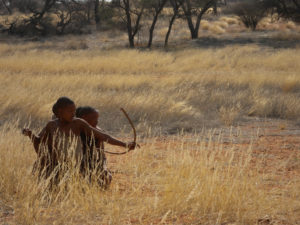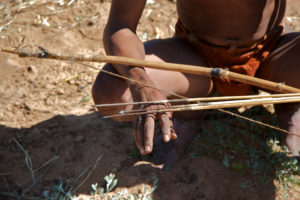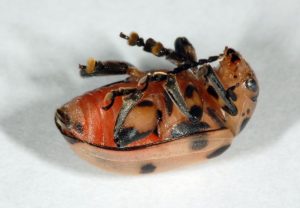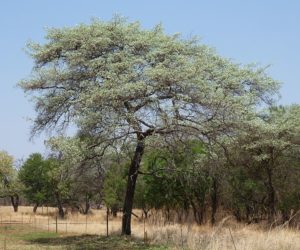The Ju/’hoan San, one the last true hunter-gathering cultures, have often been looked to as a window into the past. While this is only partially true since cultures are far from static, the study of the San’s painstaking arrow making technology may shed light on the processes and products that might have been used by prehistoric cultures to hunt more efficiently.

Fixatives (adhesives and glues), which are commonplace in our modern lifestyles, can be incredibly important in the making of traditional arrows since they provide increased strength. It is exactly this use of fixatives by the Ju/’hoan that attracted a research team led by Lyn Wadley to study the extraordinary ways these hunters extract local plant and animal resources for the making of their arrows.
The impetuses for this research are the numerous cases of residues found in archaeological sites. Identified as fixatives, these residues hint at complex tool making by past humans, and more specifically hunting tool kits. By interviewing and observing Ju/’hoan hunters in several communities in the Nyae Nyae Conservancy of Namibia, the authors hoped to create a clearer picture of prehistoric arrow making technology. This research is described in a recent paper authored by Wadley and her colleagues.

Wadley explains that simple glues have been found in sites as far back as 200,000 to 130,000 years ago in Europe when heated Birch bark and pitch were used for hafting, the process of attaching a handle to a stone implement. Yet, very little is known about compound tool manufacturing due to the lack of identifiable organic matter in many of these sites. This is why ethnographic comparisons to modern hunter-gatherers can be of great importance.
The authors not only observed the manufacturing of three fixative pastes made from plants, but also describe the making of the arrow itself, as well as arrow poisons made from grubs and plants. In addition, they make the distinction between glues as products having a single component and adhesives as a compound product. For more information on the poison arrow process, a recent review on the work of Caroline Chaboo covered in detail beetle grub and plant poison history, chemistry, and production processes by the San.

The plant fixatives that were demonstrated by Ju/’hoan hunters include Ammocharis coranica and Terminalia sericea, both of which produce simple glues. In addition, a compound adhesive was created by mixing Ozoroa schinzii latex with the grass, Aristeda adscensionis. The intricate process of creating these fixatives is described in detail by the authors, and provides an example of the well thought out sequence of events that must take place for the fixatives to be properly prepared.
After having created the fixatives, they are stored on a “glue stick” that is kept in the hunter’s quiver along with the arrows and digging sticks. In the case of the pliable Ammocharis coranica glue, it is kneaded into a ball resembling a coprolite and stored in the quiver as well.

Wadley then explains that the fixatives are used in the construction of compound arrows through an intricate process. The arrowheads, which were traditionally made of bone, are now mostly metal fashioned from wire fencing. The arrowheads are mounted on bluegrass shafts (Andropogon gayanus) and fixed with an adhesive and glue. To achieve this, the Ozoroa schinzii adhesive is applied to both ends of the shaft and sinew made from kudu ligaments is then wrapped around the adhesive to prevent splitting. The Terminalia sericea glue is then rubbed over the sinew binding as a seal while also providing a base for the poison to be applied.
The metal arrowhead, already placed in a short grass collar and wrapped in sinew as well, is then connected with the longer arrow shaft with a link made from a stem of the Grewia flava bush. The glue Terminalia sericea is used to hold both the metal point in the grass collar as well the inserted link to the same collar. After the arrow is complete the beetle and plant poisons are applied to the arrow and dried close to a fire.

Interestingly, the adhered arrowhead, collar, and link fall away from the long unglued shaft when a target is struck. Finding the long shaft allows hunters to determine if they were successful. Wadley explains that the arrow itself is not meant to be fatal, but rather is a delivery mechanism for the poison, which ultimately kills the animal.
The authors then describe the limitations and implications of their study. They acknowledge that their observations of Ju/’hoan weapon production would be very different from prehistoric circumstances. The processes used then, just as now, would have been subject to change over time and location and the group using them.

However, what the Ju/’hoan do provide is a distinct view of the complexities involved in the dissemination of knowledge, gathering of resources, and sophisticated production of compound weapons. Wadley also argues that the “creation of adhesive is a multifaceted process that involves carefully planned thought and action sequences.” Thus, “the presence of adhesives in the archaeological record is a proxy for complex cognition” (p. 4).
In regard to the recovery of archaeological remains, the study bears witness to the importance of examining artifacts such as bones, stones, and containers for residues that could reveal their use in the production of fixatives and poisons.
By conducting this ethnoarchaeologial study, Wadley and her colleagues provide a bountiful resource on Ju/’hoan weapon production and nicely compliment the work of Chaboo. While Chaboo takes a different approach by emphasizing aspects of poisons used for arrow making, Wadley further elaborates on a slowly vanishing source of traditional hunting knowledge and provides an insightful resourced into understanding the past.
Wadley, Lyn, Gary Trower, Luncinda Backwell, and Francesco d’Errico. 2015. “Traditional Glue, Adhesive and Poison Used for Composite Weapons by Ju/’hoan San in Nyae Nyae, Namibia. Implications for the Evolution of Hunting Equipment in Prehistory.” PLoS ONE 10(10): e0140269. doi:10.1371/journal.pone.0140269
By Sherrie Alexander, University of Alabama at Birmingham